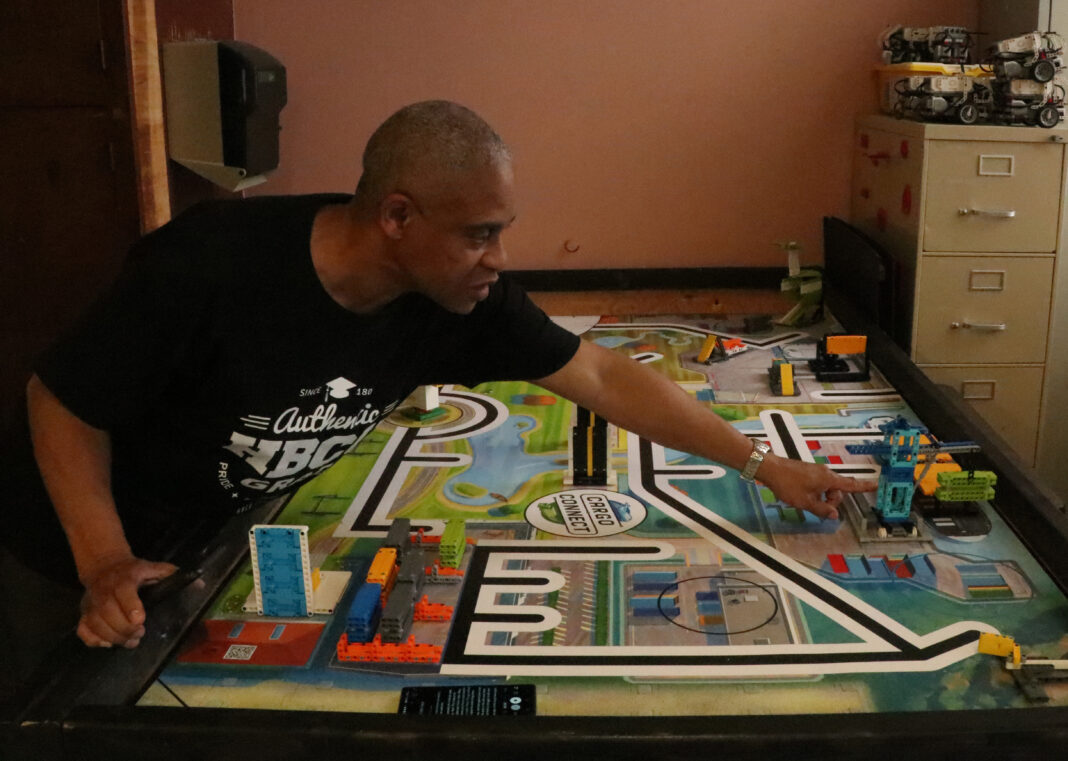Over 20 years ago Bruce Williams got hooked on something that would change his life. He was working at Johnson & Johnson while his son was playing little league baseball in Trenton. He was helping out, teaching kids how to play baseball when he heard one of the kids call him coach. Suddenly, he knew what he wanted to do with the rest of his life.
“Long story short, the first time somebody called me coach, I was hooked. So I took every (teaching) test known to man to get into the district to become a teacher, and that was December of the year 2000,” Williams said. “So I left Johnson & Johnson, let’s say on a Friday and started at Joyce Kilmer School that next Monday as a teacher.”
From that day forward, he strived to make a difference in the city’s youth as an educator in the Trenton Public School District for more than 20 years, spending the last 12 years teaching sixth-grade mathematics at Hedgepeth-Williams Middle School of the Arts.
Williams sits in his classroom waiting for students to stop by who need math tutoring. The grey hairs show his age, but his smile and laughter make you think he is younger than looks. He attributes this to having pursued his passion of becoming a teacher.
“You see these stories in Trenton about our youth, but it’s just been the opposite for me,” Williams said. “These kids are so incredibly smart. Just so incredibly talented. And I tell everybody I meet, these kids are going to cure cancer one day.”
His passion for mathematics, programming and engineering has inspired him to add an interesting spin on teaching. By incorporating LEGO Robotics into his mathematics curriculum, he lets students build, program, and connect the everyday mathematics they are learning like algebra and integers to real-world situations using the EV3 LEGO Robots.
Every week, students will program a Lego Robot to do various tasks on a map that Williams sets up. The puzzle is to code the robot to do simple tasks like follow the black line, pick up a ball or knock over a bridge.
“We started with the fundamentals. Learn how to turn (the robot), use sensors, reverse, and use the arm. Then we probably do a task per week,” Williams said. They do this by coding the robot with specific instructions; then, they work on the different tasks by trial and error.
“It’s just a way to get the kids involved with programming, and involved in understanding any STEM-like activity,” Williams said. “I tell everybody, I would love you guys be engineers. So we do this every day, every week. And we integrate this into the classroom.”
Students get points based on the level of difficulty of the test—one on the most challenging tasks being to touch an object on the far corner of the map without knocking it down. Students have to be careful and exact with their calculations.
“It’s tough because you really have to think about the steps you need. In a program, you need to accomplish every task. But they enjoy it,” Williams said.
The last two years have been tough on teachers everywhere and for Williams it was no different. Facing asynchronous learning with students, he had to adapt to online teaching and create a lesson plan to fit the ever-changing world that was the year 2020.
“(My) first reaction, I can remember just like yesterday, we got a notice via the Internet or email that classes have been canceled for students…. We knew it was a COVID-19 type pandemic going across the world. But for us, it was like, wow, no classes, how are we going to adapt to still meet the needs of the students,” Williams said.
Williams then reached out to colleagues, the principal and brainstormed a lesson plan to fit the new world of 2020. “We kind of quickly circled the wagons. For me, the old heads with the gray hair, you know, the remote learning thing, asynchronous learning by the Internet was like my parents programming the VCR…So it took me a while now. I had a steep learning curve,” Williams said.
As the pandemic came in waves, some greater than others, Williams’ passion never wavered. “I tell everybody, I stopped working 20 years ago,” Williams said. “Working with kids is great. Follow your passion. Bring your passion to the classroom, and the kids can see it.”





